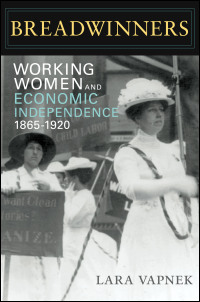 As the Great Recession drags on, we have been greeted with a stream of news stories about the family stress caused by women becoming breadwinners. 4 out of 5 jobs lost over the past three years belonged to men, leaving women as the primary wage earner in one-third of American families. “For decades,” a recent blog post claims, “moms have typically been the ones to stay at home with the kids while dads have gone off to their jobs.”
As the Great Recession drags on, we have been greeted with a stream of news stories about the family stress caused by women becoming breadwinners. 4 out of 5 jobs lost over the past three years belonged to men, leaving women as the primary wage earner in one-third of American families. “For decades,” a recent blog post claims, “moms have typically been the ones to stay at home with the kids while dads have gone off to their jobs.”
In fact, women’s role as family supporters is nothing new. The birth of the industrial era was no less disruptive to gender norms than its death, which we are now experiencing. From 1865 to 1900, the number of women working in factories in the United States quadrupled. Outraged that they earned only half of men’s wages and enjoyed few opportunities for advancement, some of these women began to organize. From 1886 to 1889, 65,000 women across the U.S. joined the Knights of Labor, the first national organization to demand equal pay for equal work.
Leonora Barry, an organizer for the Knights from upstate New York, whose husband died, leaving her with three young children to support, proudly identified herself as a “bread-winner.” She urged working men and women to accept the fact that the days when women could stay at home and attend to “domestic duties” and men could be their family’s sole provider were gone. She endorsed suffrage, hoping that women could improve their economic position by gaining a political voice.
The battle continued with Leonora O’Reilly, who joined the Knights of Labor as a teenager living and working on the Lower East Side of New York City. Like many “working girls,” her father had died. She had to leave school at age eleven and find a job to help make ends meet. Although O’Reilly’s mother was a skilled seamstress, she earned half as much as a working man—then, as now, women’s lower rates of pay reflected the assumption that women would be supported by men, rather than support families themselves.
O’Reilly believed that women could increase their wages and gain respect at work if they organized. She helped establish the Women’s Trade Union League, which brought women into unions and passed labor legislation. In 1909, she became a leader of the Uprising of the 20,000. This strike started a series of protests that brought women into garment unions and made the clothing industry a decent place work until jobs were outsourced overseas.
Like Barry, O’Reilly insisted that working women deserved recognition as breadwinners. O’Reilly helped women win the vote by arguing that the nation’s female workers– whose numbers rose from 5 million in 1900 to 8 million in 1920—deserved a chance to represent themselves politically. As she explained, in one of her characteristically direct speeches: “Women, whether you wish it or not, your first step must be to gain equal political rights with men. The next step after that must be equal pay for equal work.”
 Today, women hold half of the nation’s 132 million jobs and are set to celebrate the ninetieth anniversary of women’s suffrage. Yet the bold vision for economic equality articulated by the nation’s first generation of working women remains unfulfilled. Women’s wages have risen from 50 cents on the dollar to 78 cents. Our government remains dominated by men. President Obama’s first piece of legislation, the Lilly Ledbetter Fair Pay Act may be a sign of progress, but it needs some follow up. If the Great Recession has an upside, perhaps it will be to shatter the outdated notion that women will stay home while men go out to work, and to show us that equal pay for equal work is a matter of family survival as well as gender equity.
Today, women hold half of the nation’s 132 million jobs and are set to celebrate the ninetieth anniversary of women’s suffrage. Yet the bold vision for economic equality articulated by the nation’s first generation of working women remains unfulfilled. Women’s wages have risen from 50 cents on the dollar to 78 cents. Our government remains dominated by men. President Obama’s first piece of legislation, the Lilly Ledbetter Fair Pay Act may be a sign of progress, but it needs some follow up. If the Great Recession has an upside, perhaps it will be to shatter the outdated notion that women will stay home while men go out to work, and to show us that equal pay for equal work is a matter of family survival as well as gender equity.
*****
Lara Vapnek is Assistant Professor of History at St. John’s University and the author of Breadwinners: Working Women and Economic Independence, 1865-1920.
